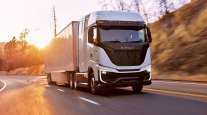Senior Reporter
Nikola Rolls Out Trucks for Zero-Emissions Future

SCOTTSDALE, Ariz. — Nikola Motor Co. CEO Trevor Milton, 28 months after unveiling a prototype Class 8 sleeper, presented to about 2,000 attendees and a global audience watching online two heavy-duty trucks and three other specialty vehicles he said are ready to spark a zero-emissions future.
The heavy-duty trucks that drove out from behind the curtains one at a time, amid swirling lights and loud music as people put their cellphones on video, were the stars of the event.
PHOTO GALLERY: Images of Nikola Two, Nikola Tre and more
As a bright red Nikola Two day cab took center stage, Milton said, “This is a real truck. This is a real [hydrogen] fuel cell,” seeming to speak to those who doubted the emerging truck maker would ever get this far.
Nikola introduced a hydrogen fuel cell Class 8 prototype Dec. 1, 2016, in Salt Lake City, its former headquarters. It is now based in Phoenix.
The day after the presentations here, Nikola offered the public a first look at the trucks as well as two zero-emissions power sport vehicles and another one designed for special forces operations, which included the ability to be operated remotely like a drone.
“We want to transform everything about the transportation industry. With Nikola’s vision, the world will be cleaner, safer and healthier,” Milton said.
"This is a real truck. This is a real fuel cell," said Trevor Milton, founder and CEO of Nikola Motor Co., which plans to market zero-emissions heavy-duty day cabs in the U.S. in 2022 and a different version in Europe in 2023. #NikolaWorld2019 pic.twitter.com/zVOhF1eRk0 — Roger Gilroy (@roger_gilroy) April 17, 2019
The flat-front Nikola Tre, bound for Europe, and the Nikola Two day cab will be available either with a hydrogen-electric fuel cell or battery-electric power. As battery-electric vehicles, customers can order either one with 500 kilowatt-hours, 750 kWh or 1 megawatt hour battery-pack options.
The U.S. truck is slated to go into initial production in 2022, after field trials. The Tre is expected to reach fleets by 2023, although Milton said during a later press conference he is looking to partner with a European truck maker to reach that market.
Both the Two and Tre have enough space in the cab to accommodate bunks and other amenities found in sleepers. Nikola noted a hydrogen fuel cell will be cheaper to operate for longhaul operations, and it expects to see 50-to-1 more hydrogen orders compared with battery-electric.

An interior view of the Tre cab. (Nikola Motor Co./YouTube)
Don Ake, vice president of commercial vehicles for FTR, said, “You have the [traditional] truck makers trying to develop electric or alternative-fuel vehicles, and this just shows the push is on and it’s a race.”
Anheuser-Busch announced nearly a year ago it placed an order for up to 800 hydrogen-electric heavy-duty day cabs.
“They will be getting the first trucks because they have agreed to share risk with us and understand that we are going to have a lot of bumps in the road at first,” Nikola President Mark Russell told Transport Topics. “New products are always kinky, and those kinks have to be worked out.
“This is a complex vehicle. It’s got a lot of parts. And that is some of the work going forward — to make it more simple to manufacture than the current iteration [would be]. If there was a range of requirements for something, we built it to the top end.”
Russell said Nikola would be building what he called “Alpha Two” trucks as lighter test vehicles “pretty soon.”
Meanwhile, there is much more to be done.
Nikola’s Coolidge, Ariz., manufacturing facility is scheduled to come online in 2022 and will be capable of building up to 35,000 trucks per year at full production. The bare site now has road access, utilities and a rail spur. It encompasses 400 acres.
Russell said just before speaking with TT, he met with a representative of a European government who said it was interested in “being in the running for our facility” to bring the Tre to that continent. He declined to identify the country.
“And then you have people in the former Eastern European bloc who are really anxious to get something like this,” he added.
Russell said all of Europe will be facing a diesel ban in the not too distant future. “Emissions are the enemy.”
In the meantime, as of April, Nikola had built one hydrogen fueling station in Phoenix. It took six months from permitting to completion.
“Imagine doing that in other places,” Russell said, as an illustration of Arizona’s favorable climate for entrepreneurial businesses. Nikola expects to create 2,000 jobs in the state.
For Anheuser-Busch, Nikola will create an initial fueling network of eight stations by 2021.

Anheuser-Busch Clydesdales at the event. (Nikola Motor Co./YouTube)
Nikola intends to have a network of 700 hydrogen fueling stations in place nationally by 2028.
Then there is a fourth round of funding — this time $1.5 billion — to be raised, Russell said, noting investors had come to the event with its strong marketing overtones.
“I promise you our model shows us becoming profitable. We start flowing cash in 2023, and then we become profitable some time after that,” Russell said.
“Our seven-year, 700,000-mile lease is going to be on a per-mile basis, and includes the hydrogen fuel,” he said. “All you have to do is provide a driver and insurance, and you have a truck.”




